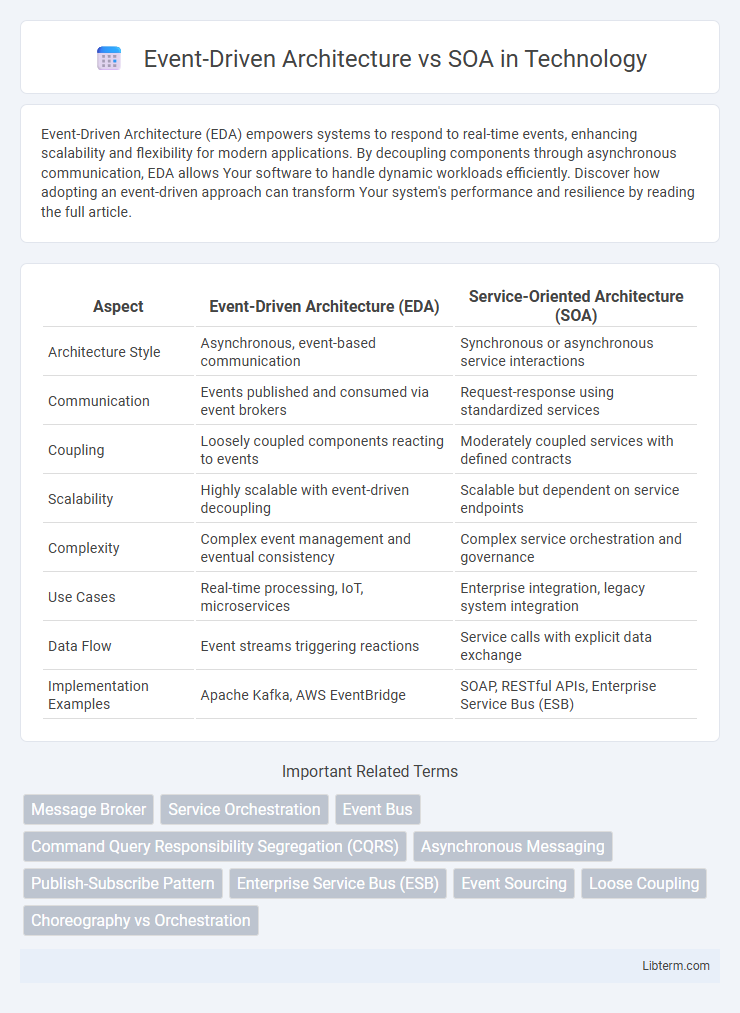Event-Driven Architecture (EDA) empowers systems to respond to real-time events, enhancing scalability and flexibility for modern applications. By decoupling components through asynchronous communication, EDA allows Your software to handle dynamic workloads efficiently. Discover how adopting an event-driven approach can transform Your system's performance and resilience by reading the full article.
Table of Comparison
| Aspect | Event-Driven Architecture (EDA) | Service-Oriented Architecture (SOA) |
|---|---|---|
| Architecture Style | Asynchronous, event-based communication | Synchronous or asynchronous service interactions |
| Communication | Events published and consumed via event brokers | Request-response using standardized services |
| Coupling | Loosely coupled components reacting to events | Moderately coupled services with defined contracts |
| Scalability | Highly scalable with event-driven decoupling | Scalable but dependent on service endpoints |
| Complexity | Complex event management and eventual consistency | Complex service orchestration and governance |
| Use Cases | Real-time processing, IoT, microservices | Enterprise integration, legacy system integration |
| Data Flow | Event streams triggering reactions | Service calls with explicit data exchange |
| Implementation Examples | Apache Kafka, AWS EventBridge | SOAP, RESTful APIs, Enterprise Service Bus (ESB) |
Introduction to Event-Driven Architecture and SOA
Event-Driven Architecture (EDA) focuses on producing, detecting, and responding to events in real-time, enabling highly responsive and scalable systems through asynchronous communication. Service-Oriented Architecture (SOA) organizes software as interoperable services that communicate via defined protocols, promoting reusable and modular business processes. Both architectures improve system integration but differ in communication patterns, with EDA emphasizing event streams and SOA relying on synchronous service requests.
Key Concepts of Event-Driven Architecture
Event-Driven Architecture (EDA) centers on the production, detection, and reaction to events, enabling real-time data processing and asynchronous communication between decoupled components. Key concepts include event producers that generate events, event consumers that respond to these events, and an event broker or bus that facilitates event distribution. This contrasts with Service-Oriented Architecture (SOA), which relies on synchronous service calls and shared contracts, making EDA more scalable and responsive for dynamic, distributed systems.
Fundamental Principles of Service-Oriented Architecture
Service-Oriented Architecture (SOA) is founded on principles such as loose coupling, reusability, and standardized service contracts to enable interoperable and flexible integration across diverse systems. These services communicate through well-defined interfaces, promoting modularity and allowing independent deployment and evolution. SOA emphasizes centralized governance, service discoverability, and business-aligned service abstraction to ensure scalable and maintainable enterprise solutions.
Core Differences Between EDA and SOA
Event-Driven Architecture (EDA) focuses on real-time event processing where components communicate through event notifications, enabling highly decoupled and asynchronous interactions. Service-Oriented Architecture (SOA) emphasizes explicit service contracts and standardized interfaces for synchronous or asynchronous service communication, often supporting business process integration. Core differences include EDA's reliance on event streams and publish-subscribe models versus SOA's use of request-response services and orchestration for system interoperability.
Communication Patterns in EDA vs SOA
Event-Driven Architecture (EDA) leverages asynchronous communication patterns where events trigger responses, enabling real-time data flow and loosely coupled services. In contrast, Service-Oriented Architecture (SOA) typically employs synchronous request-response messaging, emphasizing structured service contracts and orchestrated workflows. EDA's publish-subscribe model enhances scalability and flexibility, whereas SOA's point-to-point communication prioritizes reliability and transactional integrity.
Scalability and Flexibility Comparison
Event-Driven Architecture (EDA) offers superior scalability by enabling asynchronous communication and decoupling of services, allowing systems to handle high volumes of events without bottlenecks. In contrast, Service-Oriented Architecture (SOA) relies on synchronous service calls, which may introduce latency and limit flexibility under heavy load. EDA also enhances flexibility through real-time event processing and dynamic event routing, whereas SOA provides structured service reuse but with less adaptability to rapid changes in business requirements.
Use Cases: When to Choose EDA or SOA
Event-Driven Architecture (EDA) excels in use cases requiring real-time data processing, high scalability, and asynchronous communication, ideal for IoT, microservices, and dynamic event handling systems. Service-Oriented Architecture (SOA) suits business processes demanding robust service integration, synchronous request-response interactions, and legacy system interoperability, common in enterprise resource planning (ERP) and customer relationship management (CRM) solutions. Selecting EDA or SOA depends on application needs: EDA for responsive, event-triggered workflows; SOA for structured, service-based business functions.
Integration and Interoperability Considerations
Event-Driven Architecture (EDA) emphasizes real-time, asynchronous communication through events, enabling loosely coupled systems that enhance scalability and flexibility in integration. Service-Oriented Architecture (SOA) relies on well-defined, synchronous service contracts, promoting interoperability through standardized protocols like SOAP and REST. Integration in EDA supports dynamic, event-based workflows ideal for reactive systems, while SOA excels in structured, request-response interactions suited for enterprise-wide service orchestration.
Advantages and Challenges of Each Approach
Event-Driven Architecture (EDA) offers real-time data processing and scalability by decoupling components through event messaging, enabling responsive systems suited for dynamic environments; however, it can introduce complexity in event management and debugging. Service-Oriented Architecture (SOA) promotes reusability and interoperability by structuring services with defined interfaces, supporting enterprise integration and standardized communication, yet it may suffer from latency issues and increased overhead due to synchronous service calls. Both architectures enhance modularity but require careful design to address their inherent challenges related to event orchestration in EDA and service coordination in SOA.
Future Trends in Event-Driven and Service-Oriented Architectures
Future trends in event-driven architecture (EDA) emphasize real-time data processing, increased use of microservices, and enhanced scalability through serverless computing. In service-oriented architecture (SOA), the focus shifts towards greater API integration, improved interoperability with hybrid cloud environments, and adoption of AI-driven service management. Both architectures are converging towards more modular, flexible systems that support edge computing and continuous integration/continuous deployment (CI/CD) pipelines.
Event-Driven Architecture Infographic

 libterm.com
libterm.com